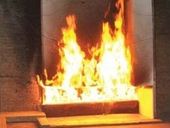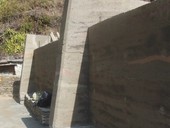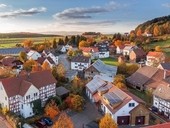Dowel joints with wooden fasteners are an important part of many timber structures. They have been used especially in historical timber structures. This type of fasteners can be used for the construction of modern wooden structures or for the production of individual wooden structural elements, such as the Holz100 system of the Austrian company Thoma or for similar Brettstapel structural elements. Actual normative materials (principally Eurocode 5) do not provide sufficient safe design description for such structural joints. A complex model of failures in different directions to the grain of wood is missing. The article focuses on a pilot study on the evaluation of mechanical behaviour of dowel joints and presents the results of experiments of all-wood joints with dowels made of various wood species.
Archiv článků od 8.10.2018 do 14.12.2018
The mechanical properties of earthen building material have been intensively investigated for the last fifty years. Different earth mixtures are used for different building technologies, such as walls, bricks or plasters. Therefore, it is almost impossible to set a specific numerical value for a parameter in general. These values may vary significantly and are listed within range. The properties of each earth mixture are dependent on the clay content (type of clay minerals), filler, water and additives. Depending on the building technology several tests can be performed to determine the mechanical properties. This review article discusses mechanical properties of earth, the tests and limit values. These properties include density, binding force, compressive strength, tensile strength, bending tensile strength, bond strength, resistance to abrasion, modulus of elasticity and impact strength of corners.
The paper summarizes latest research on the influence of natural clay materials and earth structures on the quality of indoor microclimate regarding relative humidity. This laboratory research has been carried out at FCE CTU in Prague and UCEEB CTU in Prague and focuses on the dynamic sorption properties of building structures based on natural clays compared to building structures based on common building materials.
The article describes basic principles of the SBToolCZ green building assessment methodology stressing its up-to-date methods for school buildings. An example of a certified school is given. Renovation of this school was assessed and optimised by the SBToolCZ system which lead to the conversion into intelligent, zero energy building.
The article focuses on assessment of fire closure of external walls and is divided into two parts – a current state of knowledge and an experimental part. The current state of knowledge summarises methods for assessing the fire closure of external walls – calculation methods (heat flux density, heat release rate, mathematical models) and fire tests (cone calorimetry, reaction to fire test for facades or fire resistance test). The experimental part builds on the state of knowledge and is divided into two experiments – the test in a cone calorimeter and an alternative test of fire closure.
The paper presents the building-physical context of the use of roof windows in buildings with very low energy demand. It shows their relatively significant influence on the total heat loss of a single family house and the consequence of the specific disadvantageous set-up in the pitched roof. It is shown that the thermal transmittance should not exceed 0.7 W/(m2K) with a strict limitation of thermal coupling in the connection to the roof. In the second part, the paper shows the positive effect of the slanting of the inner lining on the quality of day lighting.
In July 2018, a two-year monitoring of the FENIX Group a.s. in Jeseník. During this time, different battery operating modes were applied to test their capabilities to ensure the power operation of the object. This article describes the entire period in terms of energy flows in the building. The key parameters are energy consumption, supply to the grid, self-sufficiency of the building from the photovoltaic source and its local use. A number of articles have been written about the building, detailing the building and energy aspects [1, 2]. Therefore, the description of the energy economy in the building will be given only to the extent necessary for a general view of the building's energy.
Ability of transfer of combustion through the safety gap is an important feature of flammable gases or vapors of flammable gases. This maximum experimental safety gap, which is experimentally determined, is used as a safety element during transport, storage, and generally handling with flammable substances. Maximum Experimental Safe Gap (MESG) is a standardized measurement of how easily a gas (or vapour) flame will pass through a narrow gap forming by two surfaces. Testing methodology and precise application of results are given in ČSN EN 60079-20-1. This standard and other regulations prescribe the determination of the maximum experimental safety gap under atmospheric conditions. In today´s technology, transport and storage of flammable substances a work under increased pressures is very common. For safety reasons, a method and test facility for the determination of maximum experimental safety gap under non-atmospheric conditions was proposed.
Earth is one of the oldest building materials and in many countries still the most common building material, often preffered for its low cost and self-construction possibilities. Also in Europe, soil was used for centuries as a building material and nowadays expanding again because of it´s enviromental characteristics. Unfortunatelly, traditional unstabilized earth buildings are vulnerable to earthquakes and as many earthen buildings are located in earthquake prone areas, serious damages and life-threatening collapse of many houses occurs regullary. This article shows possibilities of seismic protection and earthquake resistant construction techniques of traditional earthen buildings.
Analysis and design of reinforced concrete structures requires knowledge of the mechanical properties of the materials used. In the case of nonlinear analysis, a higher range and detail of mechanical properties of concrete is needed. The article focuses on the description of strength characteristics of concrete, attention is paid to the strength of concrete in the tension. The testing was focused on the split tension test and the three-point and four-point bending test. The obtained mechanical properties of concrete are subsequently applied in the nonlinear analysis of reinforced concrete beam without shear reinforcement, which has been subjected to a load test.
The methodology for determining energy-neutral or energy-zero houses is different at national levels. The interest in the realization of such houses is not only influenced by the methodology but also by the market conditions in the area of moving surplus energy production from one object to another. This is an economically disadvantageous purchase price when delivering to the network. If the existing conditions in the Czech Republic are not changed, the implementation of energy-zero houses for investors will not be interesting and the potential for reduction of CO2 production will not be utilized.
This paper will present a survey of the ladder safety from a firefighter point of view, the analysis of the standard and proposing possible modifications of the standard, analytical analysis of ladder composition by optical emission spectroscopy and X-ray fluorescence spectroscopy and current large-dimensional tests carried out in the Technical Institute of Fire Protection and the objectives we would like to achieve in the research project.
The clay bricks produced by extruding (continuous compression) generally have a high proportion of clay. The use of this bricks in buildings is beneficial in terms of the amount of built-in clay in building structures. The positive effects of these clay materials in the living space are generally known, however, using as a support for clay plaster has some difficulties, which are less known. The issue of the application of clay plaster in extruded clay bricks is the subject of my long-term interest.
Concrete is a composite material with significantly different value of tensile and compressive strength. Tensile strength is usually only 1/10 of compressive strength. With admixture of steel fibers it is possible to enlarge the tensile strength. The paper deals with testing and consequent determination of tensile strength of fiber concrete with the amount of fibers 25, 50, 75 kg/m3. Four series, each with more than 23 specimens, were tested. Tensile strength testing implied a few variant of bending test with different span (500 mm or 600 mm), different load configuration (three or four point bending), with or without notch. Results of cube and cylindrical compressive strength and transverse tensile strength are also presented.
Building objects that have been severely damaged by an explosion of explosives, gas or technological breakdowns threaten surrounding area by their unstable state. Their damage is usually so severe that no repair or reconstruction is considered, and the only possible solution is quick demolition. In these risky situations, the emergency state of the building can be advantageously solved by using special charges with an effect which will ensure a rapid reconstruction of the unstable state of the building without endangering the environment, especially in built-up areas of cities.
Due to increasing amount of construction and demolition waste (C&DW), new recycling methods and applications of secondary raw materials are searched. The biggest part of C&DW is old concrete and mortar which can be used for production of recycled concrete aggregates (RCA). To protect the nature and decrease amount of mined natural aggregates, RCA could partially or totally replace natural aggregates used for production of new concrete. This article presents the factors which have influence on the RCA properties. Properties of three different types of RCA were analysed and results compared with properties of natural aggregates. Description of connection between factors and properties of RCA are discussed. Results showed that not only origin and amount of impurities has influence on applicability of RCA as a replacement of natural aggregates for new concrete production.
A lot of family houses from recent history have problems with low air humidity in winter. Earth materials, such as earth plaster or wall made of earth bricks, can be the right solution for ecologically-minded builders who prefer low energy consumption solutions for thermal and humidity stability issues of indoor climate. Yet, this solution still requires some proactive behaviour from its users.
Smart management is an important part of the Smart Cities concept. Facility management applied in the commercial sector is a functioning platform that has already gained its place in the company. It deals not only with property management but also with work with people so that the place in which they work and live should be the place with the best conditions for them. This principle should be applied more so in municipal self-government. Municipal management is also deal with about ensuring these "ideal" conditions, but also about property management. And these processes need to be combined, connected and optimized very handy and efficient. However, there is a lot of activity associated with it, so just as in facility management, it can be helped by quality software support.
zpět na aktuální články



















